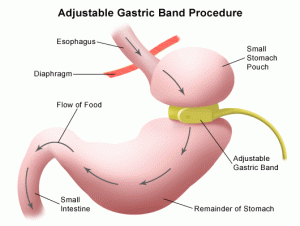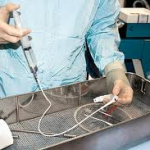A laparoscopic adjustable gastric band, commonly referred to as a lap band, is an inflatable silicone device placed around the top portion of the stomach to treat obesity by reducing the amount of food consumed.
 Adjustable gastric band surgery is an example of bariatric surgery designed for obese patients with a body mass index (BMI) of 40 or greater—or between 35–40 in cases of patients with certain comorbidities that are known to improve with weight loss, such as sleep apnea, diabetes, osteoarthritis, GERD, Hypertension (high blood pressure), or metabolic syndrome, among others.
Adjustable gastric band surgery is an example of bariatric surgery designed for obese patients with a body mass index (BMI) of 40 or greater—or between 35–40 in cases of patients with certain comorbidities that are known to improve with weight loss, such as sleep apnea, diabetes, osteoarthritis, GERD, Hypertension (high blood pressure), or metabolic syndrome, among others.
In February 2011 the U.S. Food and Drug Administration (FDA) expanded approval of Adjustable gastric band to patients with a BMI between 30 to 40 and one weight-related medical condition such as diabetes or high blood pressure. However, an adjustable gastric band may only be used after other methods such as diet and exercise have previously been tried.
How gastric banding works
The inflatable band is placed around the upper part of the stomach to create a smaller stomach pouch. This restricts the amount of food that can be consumed at one time and increases the time taken for the stomach to empty. The patient achieves sustained weight loss by limiting food intake, reducing appetite, and slowing digestion.
According to the American Society for Metabolic Bariatric Surgery, bariatric surgery is not an easy option for obesity sufferers. It is a drastic step, and carries the usual pain and risks of any major gastrointestinal surgical operation.
However, gastric banding is the least invasive surgery of its kind. Gastric banding is performed using laparoscopic surgery and usually results in a shorter hospital stay, faster recovery, smaller scars, and less pain than open surgical procedures. Because no part of the stomach is stapled or removed, and the patient’s intestines are not re-routed, he or she can continue to absorb nutrients from food normally. Gastric bands are made entirely of biocompatible materials, so they are able to stay in the patient’s body without causing harm.
However, not all patients are suitable for laparoscopy. Patients who are extremely obese, who have had previous abdominal surgery, or have complicating medical problems may require the open approach.
Placement via laparoscopic surgery
 The surgical insertion of an adjustable gastric band is often referred to as a lap band procedure. First, a small incision (typically less than 1.25 cm or 0.5 in.) is made near the belly button. Carbon dioxide (a gas that occurs naturally in the body) is introduced into the abdomen to create a work space for the surgeon. Then a small laparoscopic camera is placed through the incision into the abdomen. The camera sends a picture of the stomach and abdominal cavity to a video monitor. It gives the surgeon a good view of the key structures in the abdominal cavity. A few additional, small incisions are made in the abdomen. The surgeon watches the video monitor and works through these small incisions using instruments with long handles to complete the procedure. The surgeon creates a small, circular tunnel behind the stomach, inserts the gastric band through the tunnel, and locks the band around the stomach.
The surgical insertion of an adjustable gastric band is often referred to as a lap band procedure. First, a small incision (typically less than 1.25 cm or 0.5 in.) is made near the belly button. Carbon dioxide (a gas that occurs naturally in the body) is introduced into the abdomen to create a work space for the surgeon. Then a small laparoscopic camera is placed through the incision into the abdomen. The camera sends a picture of the stomach and abdominal cavity to a video monitor. It gives the surgeon a good view of the key structures in the abdominal cavity. A few additional, small incisions are made in the abdomen. The surgeon watches the video monitor and works through these small incisions using instruments with long handles to complete the procedure. The surgeon creates a small, circular tunnel behind the stomach, inserts the gastric band through the tunnel, and locks the band around the stomach.
Clinical studies of laparoscopic (minimally invasive) bariatric surgery patients found that they felt better, spent more time doing recreational and physical activities, benefited from enhanced productivity and economic opportunities, and had more self-confidence than they did prior to surgery.
Mechanics
 The placement of the band creates a small pouch at the top of the stomach. This pouch holds approximately ½ cup of food, whereas the typical stomach holds about 6 cups of food. The pouch fills with food quickly, and the band slows the passage of food from the pouch to the lower part of the stomach. As the upper part of the stomach registers as full, the message to the brain is that the entire stomach is full, and this sensation helps the person to be hungry less often, feel full more quickly and for a longer period of time, eat smaller portions, and lose weight over time.
The placement of the band creates a small pouch at the top of the stomach. This pouch holds approximately ½ cup of food, whereas the typical stomach holds about 6 cups of food. The pouch fills with food quickly, and the band slows the passage of food from the pouch to the lower part of the stomach. As the upper part of the stomach registers as full, the message to the brain is that the entire stomach is full, and this sensation helps the person to be hungry less often, feel full more quickly and for a longer period of time, eat smaller portions, and lose weight over time.
As patients lose weight, their bands will need adjustments, or “fills,†to ensure comfort and effectiveness. The gastric band is adjusted by introducing a saline solution into a small access port placed just under the skin. A specialized non-coring needle is used to avoid damage to the port membrane and prevent leakage. There are many port designs (such as high profile and low profile), and they may be placed in varying positions based on the surgeon’s preference, but are always attached (through sutures, staples, or another method) to the muscle wall in and around the diaphragm.
Adjustable gastric bands hold between 4 to 12 cc of saline solution, depending on their design. When the band is inflated with saline solution, it places pressure around the outside of the stomach. This decreases the size of the passage between the pouch created from the upper part of the stomach and the lower stomach and further restricts the movement of food. Over the course of several visits to the doctor, the band is filled until the optimal restriction has been achieved – neither so loose that hunger is not controlled, nor so tight that food cannot move through the digestive system. The number of adjustments required is an individual experience and cannot be accurately predicted.
